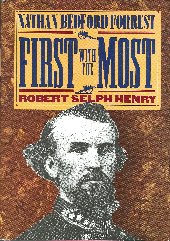
|
Nathan Bedford Forrest First with the Most By: Robert Selph Henry
|

|
Nathan Bedford Forrest First with the Most By: Robert Selph Henry
|
ABOUT THE BOOK
Nathan Bedford Forrest did not invent mobilized guerilla warfare, but he did modernize and polish it to an extent that has left few theoretical areas for improvement. Tanks and jeeps, it could even be said, do not possess the mobility relative to the main force which they attach that Forrest’s dedicated band of horsemen enjoyed.
Following in the footsteps of Francis Marion and Lighthorse Harry Lee, American practitioners of the devastating hit-and-run cavalry attach of the Revolutionary War, Forrest raised their effective but geographically limited campaigns to an art-form spread over the widest possible tactical theatre. He accomplished this with superior knowledge of terrain and of horses coupled and with an iron will, a complete disregard for physical exhaustion (his own and that of his men) and, this book will demonstrate, by the most admirable sort of sheer country orneriness. ABOUT THE AUTHOR
Robert Selph Henry, (20 October 1889 - 19 August 1970),
was born at Clifton, Wayne County, Tennessee on 20 October 1889, the son of Robert Allison Henry and Jemima Emily Selph. His parents were married 28 Dec 1887 in Clifton. Jemima Emily Selph was the daughter of Dr. Irby N. Selph, noted physician in Clifton.
Not long after his birth, Robert Selph Henry moved to Nashville, Tennessee with his family. He graduated from Vanderbilt in 1911 and did post graduate work at Queens College in Cambridge, England. He was admitted to the Tennessee bar in 1911 and practiced law in Nashville, Tennessee from 1915 to 1921. In 1921 he became assistant to the president of the Nashville, Chattanooga and St. Louis Railroad and remained in that position until 1934.
Henry was a student of the South and the Civil War. His book, "The Story of the Confederacy" published in 1937, was considered for many years to be the definitive history of the rise of the Confederate States of America and the Civil War (or War of Rebellion/ War Between the States).
Robert Selph Henry died in Nashville, Tennessee, 19 August 1970.
- Now Available at the Quartermaster's Table -
|